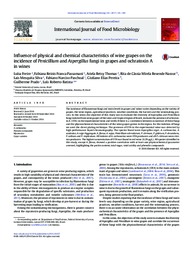Influence of physical and chemical characteristics of wine grapes on the incidence of Penicillium and Aspergillus fungi in grapes and ochratoxin A in wines.
Influence of physical and chemical characteristics of wine grapes on the incidence of Penicillium and Aspergillus fungi in grapes and ochratoxin A in wines.
Author(s): FREIRE, L.; PASSAMANI, F. R. F.; THOMAS, A. B.; NASSUR, R. de C. M. R.; SILVA, L. M.; PASCHOAL, F. N.; PEREIRA, G. E.; PRADO, G.; BATISTA, L. R.
Summary: The incidence of filamentous fungi and toxin levels in grapes and wines varies depending on the variety of grapes, the wine region, agricultural practices, weather conditions, the harvest and the winemaking process. In this sense, the objective of this study was to evaluate the diversity of Aspergillus and Penicillium fungi isolated fromwine grapes of the semi-arid tropical region of Brazil, evaluate the presence of ochratoxin A (OTA) in the experimental wine and verify if there is a correlation between occurrence of these fungi and the physicochemical characteristics of the wine grapes grown in the region. For the isolation of fungi we used the direct plating technique. The presence of OTA in the experimental wine was detected by high-performance liquid chromatography. The species found were Aspergillus niger, A. carbonarius, A. aculeatus, A. niger Aggregate, A. flavus, A. sojae, Penicillium sclerotiorum, P. citrinum, P. glabrum, P. decumbens, P. solitum and P. implicatum. All isolates of A. carbonarius were OTA producers and all P. citrinum were citrinin producers. The highest concentration of OTA was found in red wine (0.29 ?g/L). All species identified in this study, except A. flavus, showed a positive correlation with at least one physicochemical parameter assessed, highlighting the pectin content, total sugar, total acidity and phenolic compounds.
Publication year: 2016
Types of publication: Journal article
Unit: Embrapa Grape & Wine
Keywords: Doenca de planta, Fungo, Fungo filamentoso, Fungo isolado, Uva, Vinho
Observation
Some of Embrapa's publications are published as ePub files. To read them, use or download one of the following free software options to your computer or mobile device. Android: Google Play Books; IOS: iBooks; Windows and Linux: Calibre.
Access other publications
Access the Agricultural Research Database (BDPA) to consult Embrapa's full library collection and records.
Visit Embrapa Bookstore to purchase books and other publications sold by Embrapa.

